1.原型链继承:使子类构造函数的prototype为父类构造函数的实例对象。
缺点:1.无法传参;
2.如果存在引用类型,该值会被所有实例所共享,修改则会影响其他实例;
优点:实现简单
function Parent(){
this.name = 'xiaoming';
this.age = 10;
this.color = ['red','yello'];
};
Parent.prototype.say = function(){
console.log(`my name is ${this.name},i'm ${this.age} years old`);
};
//子类构造函数
function Son(){
this.sex = 'F';
};
Son.prototype = new Parent();
Son.prototype.constructor = Son;
//创建对象实例
const son1 = new Son();
const son2 = new Son();
son1.color.push(' purple');
console.log(son1,son2);
结果:

2.构造函数继承:在子类构造函数中通过call/apply调用父类构造函数。
缺点:1.无法继承父类构造函数原型上的方法和属性;
优点:1.解决啦原型链继承不能传参的问题;
2.解决啦引用类型互相影响的问题。
function Parent(name,age){
this.name = name;
this.age = age;
this.color = ['red','yellow'];
};
Parent.prototype.say = function() {
console.log(`my name is ${this.name},i'm ${this.age} years old`);
};
function Son(sex,name,age) {
this.sex = sex;
Parent.call(this,name,age);
};
const son1 = new Son('F','rose',18);
const son2 = new Son('M','mark',19);
son1.color.push('purple');
console.log(son1,son2);
结果:
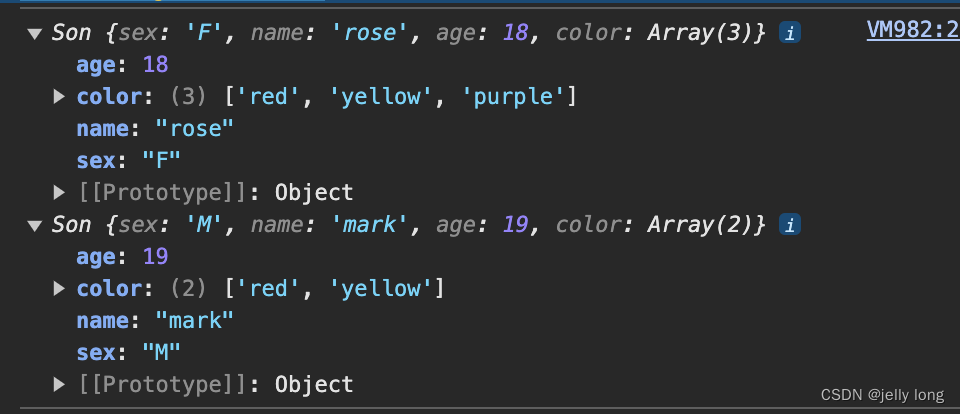
3.组合继承:结合原型链继承和构造函数继承。
缺点:无论什么情况,都会调用两次父类构造函数,造成不必要的性能开销。
优点:1.解决啦原型链继承不能传参的问题;
2.解决啦引用属性互相影响的问题;
function Parent(name,age) {
this.name = name;
this.age = age;
this.color = ['red','yellow'];
};
Parent.prototype.say = function() {
console.log(`my name is ${this.name},i'm ${this.age} years old`);
};
function Son(sex,name,age) {
this.sex = sex;
//继承父类构造函数中的实例属性和方法
Parent.call(this,name,age);
};
//继承父类构造函数原型上的属性和方法
Son.prototype = new Parent();
const son1 = new Son('F','rose',18);
const son2 = new Son('M','mark',19);
son1.color.push('purple');
console.log(son1,son2);
结果:
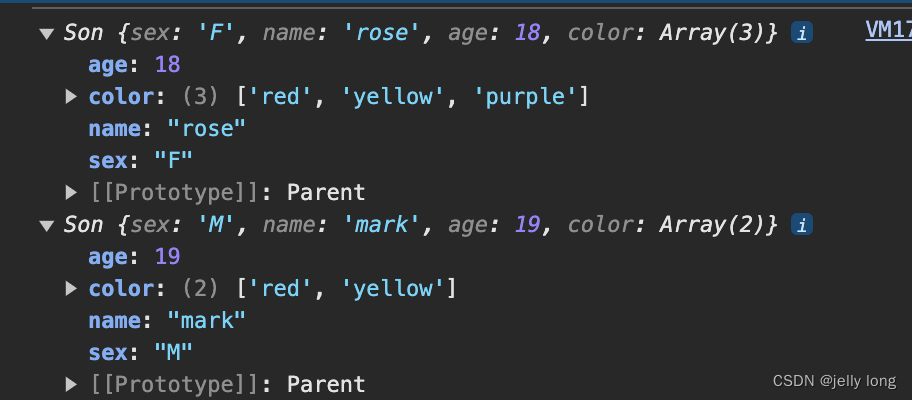
4.原型式继承:通过Object.create()将父类的实例对象赋值给实例。
缺点:1.无法传参;
2.引用类型会互相影响;
3.无法实现复用
优点:无需创建子类构造函数;
function Parent(){
this.name = 'test';
this.color = ['red','yellow'];
};
Parent.prototype.say = function() {
console.log(this.name);
};
let Child = new Parent();
const child1 = Object.create(Child);
const child2 = Object.create(Child);
child1.color.push('purple');
console.log(child1,child2);
结果:
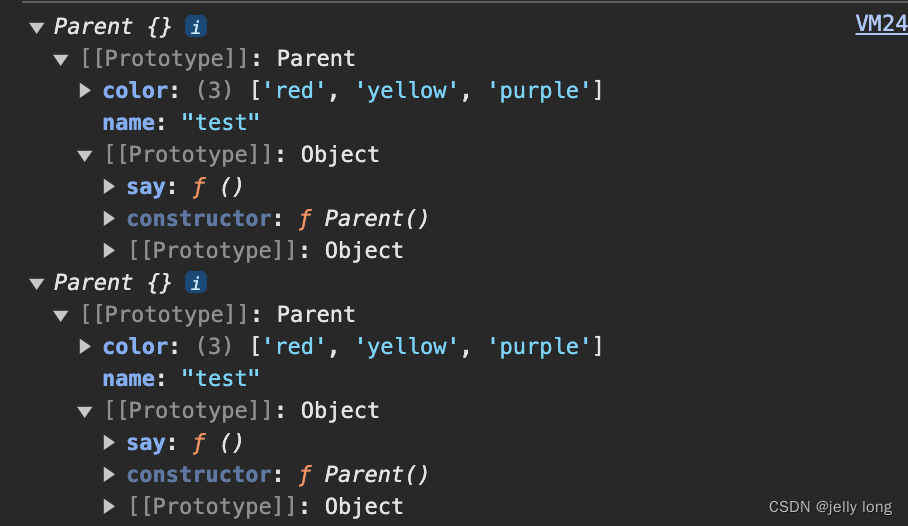
5.寄生式继承:其实就是给原型式加拉一层外壳。
function createObj(obj) {
const child = Object.create(obj);
child.sayName = function(){
console.log(this.name);
}
return child;
}
function Parent(){
this.name = 'test';
this.color = ['red','yellow'];
};
Parent.prototype.say = function() {
console.log(this.name);
};
let obj = new Parent();
const child1 = createObj(obj);
const child2 = createObj(obj);
child1.color.push('purple');
console.log(child1,child2);
结果:
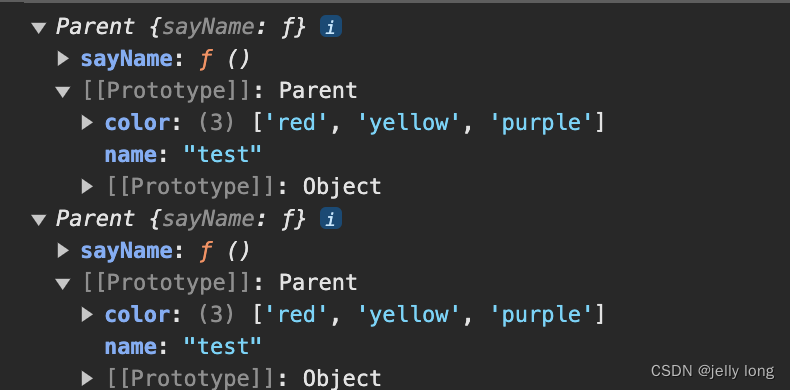
6.寄生组合式继承:是原型链继承+构造函数继承+原型式继承的结合。
缺点:实现步骤略复杂
优点:解决啦组合继承调用两次父类构造函数的问题
function Parent(name,age){
this.name = name;
this.age = age;
this.color = ['red','yellow'];
};
Parent.prototype.say = function() {
console.log(`my name is ${this.name},i'm ${this.age} years old`);
};
//创建一个父类构造函数原型对象
const prototypeObj = Object.create(Parent.prototype);
//创建子类构造函数
function Child(sex,name,age){
this.sex = sex;
//继承父类的实例属性和方法
Parent.call(this,name,age);
};
//继承父类构造函数原型上的属性和方法
Child.prototype = prototypeObj;
Child.prototype.constructor = Child;
const child1 = new Child('F','rose',18);
const child2 = new Child('M','mark',19);
child1.color.push('purple');
console.log(child1,child2);
结果:
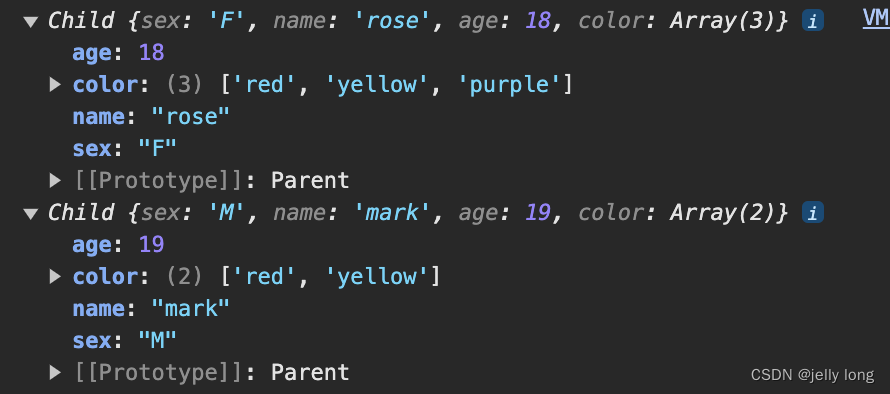
额外补充Object.create():
Object.create()用于创建一个新的对象,使用现有的对象来创建新对象的__proto__,被创建的对象会继承另一个对象的原型。
使用方法:Object.create(proto,propertiesObject);
proto,{object},新对象要继承的对象/要继承对象的原型。
propertiesObject,{object},可选参数,为新创建对象指定的属性对象。
详细可参考链接:https://blog.csdn.net/muzidigbig/article/details/89179459





















 1256
1256

 被折叠的 条评论
为什么被折叠?
被折叠的 条评论
为什么被折叠?








